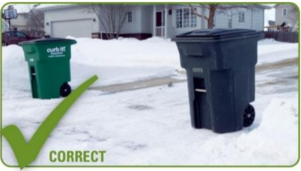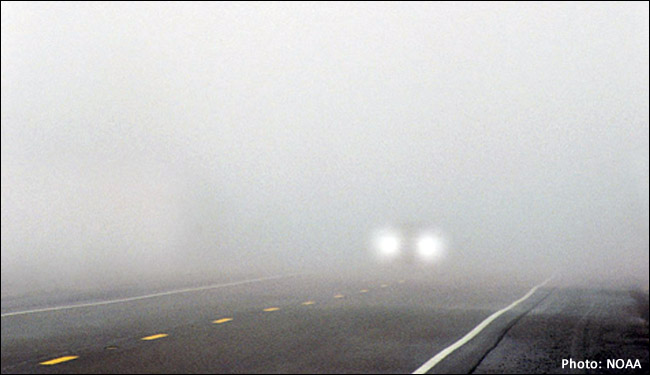|
January 2023 | Volume 13 | Issue 1 | 
|
|

Michigan's winter weather can make it difficult for snowplows to avoid garbage cans placed alongside the road.
To avoid a scenario where a snowplow vehicle damages your trash cans, it may be necessary to postpone putting your trash out on pick-up days during a snowstorm.
Here are a few helpful tips that are sure to come in handy during the winter months when it comes to dealing with roadside waste:
Dig out a spot adjacent to your driveway for your garbage can. Having a place for the can to go can help keep it protected during snow removal operations.
Do not place garbage cans in the street. We realize this cleared area is an enticing location to place garbage cans, but it creates a hazard as they could get hit by vehicles or snowplows.
|

Additionally, most garbage trucks are equipped with a hydraulic extending arm that grasps garbage cans. It is recommended that garbage cans be placed at least 3 to 5 feet off the edge of pavement, into your driveway. In this location they are out of the way of the snowplow or snow being pushed aside while the snowplow is going down the road.
Do not place garbage cans on top of the snow piles. This might cause your garbage can to tip over and litter your garbage along the street. Placing them high off the ground can also make it difficult for garbage trucks to set carts back down.
Retrieve your garbage cans soon after collection. Garbage cans often sit at the roadside on collection day until the evening. Empty cans are vulnerable to winds and snow removal operations and could cause a hazard if knocked into the roadway. Prompt removal of empty containers is recommended.
These tips can make garbage collection day safer and easier for snowplow and garbage truck drivers.
|

Is it safe to pass a snowplow?
The Road Commission encourages motorists to be extra cautious as slippery roads, reduced visibility, and excessive speeds greatly reduce the margin of error during winter driving.
Road Commission snowplows travel at slower speeds than the normal traffic to clear snow and apply salt. Motorists may be inclined to pass the snowplows, but it is not recommended.
The action of passing can be extremely dangerous due to pavement conditions that vary across the path taken to pass.
Snowplows may be equipped with wing plow blades that can extend off to the right anywhere between 2 and 10 feet beyond the width of the truck. This wing plow blade is often not seen because of the snow cloud created by the snowplow.
These wing plows can often weigh as much as a compact car. If you attempt to pass a snowplow on the right, you may not see the snowplow blade and run the risk of a serious crash.
|

Despite the best efforts of the winter maintenance crews, lawns along the edge of the road may occasionally be damaged during snow removal.
If you've experienced lawn damage along the road right of way due to winter maintenance activities, you're asked to contact the Road Commission at (616) 842-5400 on normal business days between 7:30 AM and 4 PM.
You may also utilize our online service request form at https://www.ottawacorc.com/
Your address will be placed on a list for spring cleanup once all the snow is melted. Lawn damage is restored by Road Commission crews with the placement of topsoil and grass seed.
To minimize lawn damage, the Road Commission installs wooden stakes at various locations to mark the edge of pavement prior to the first snow event.
The stakes are typically installed at intersections or curves within subdivision streets that are difficult for snowplow drivers to judge. These stakes may break off after a couple of plowing operations, but they do serve a purpose in establishing appropriate plowing limits so please try and keep these stakes in place.
|

Fog can be present any time of year, but can be especially troublesome during the winter and early spring when snow begins to melt and temperatures warm.
Fog, particularly when dense, can be hazardous to drivers and contributes to numerous travel accidents every year.
If you must drive in foggy conditions, keep the following safety tips in mind:
- Slow down and allow extra time to reach your destination.
- Make your vehicle visible to others both ahead of you and behind you by using your low-beam headlights since this means your taillights will also be on. Use fog lights if you have them.
- Never use your high-beam lights. Using high beam lights causes glare, making it more difficult for you to see what’s ahead of you on the road.
- Leave plenty of distance between you and the vehicle in front of you to account for sudden stops or changes in the traffic pattern.
- To ensure you are staying in the proper lane, follow the lines on the road with your eyes.
- Make sure to keep an extra eye out for deer that may be alongside or in the roadway.
- In extremely dense fog where visibility is near zero, the best course of action is to first turn on your hazard lights, then simply pull into a safe location such as a parking lot of a local business and stop.
If there is no parking lot or driveway to pull into, pull your vehicle off to the side of the road as far as possible. Once you come to a stop, turn off all lights except your hazard flashing lights, set the emergency brake, and take your foot off of the brake pedal to be sure the tail lights are not illuminated so that other drivers don't mistakenly run into you.
|
|
|
|
Important Dates:
January 12, 2023 | 9 a.m. | Board Meeting
January 26, 2023 | 9 a.m. | Board Meeting
View Meeting Minutes & Agendas
|
|